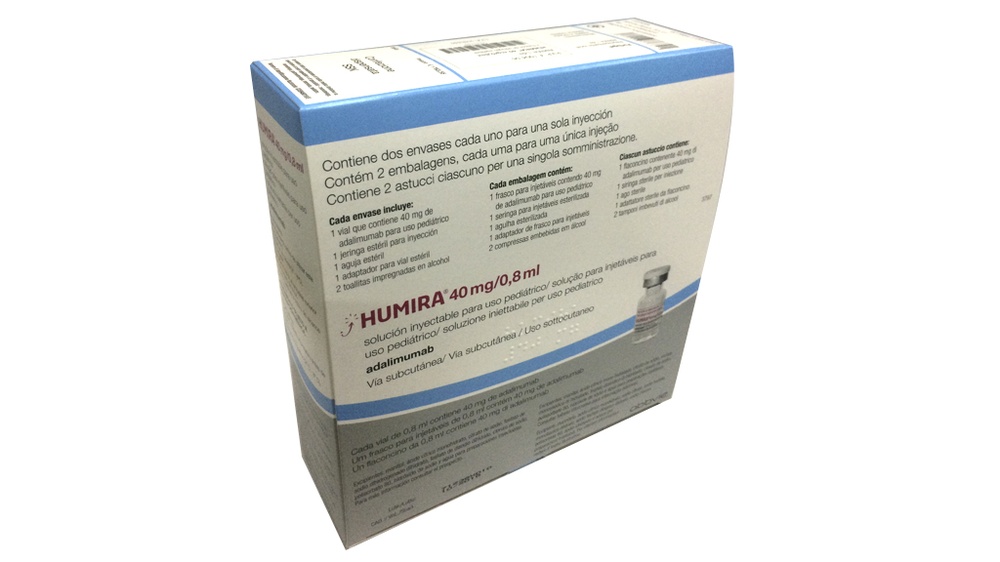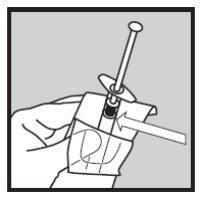
How to use HUMIRA 40 mg/0.8 ml INJECTABLE SOLUTION FOR PAEDIATRIC USE
Introduction
Package Leaflet: Information for the Patient
Humira 40 mg/0.8 mlinjectable solution
adalimumab
Read this package leaflet carefully before your child starts using this medicine, as it contains important information for you.
- Keep this package leaflet, as you may need to read it again.
- Your doctor will give you a patient information card, which contains important safety information that you need to know before and during your child's treatment with Humira.
Keep this patient information cardfor you or your child.
- If you have any questions, ask your doctor or pharmacist.
- This medicine has been prescribed to your child only, and you should not give it to others, even if they have the same symptoms as your child, as it may harm them.
- If your child experiences side effects, consult your doctor or pharmacist, even if they are side effects not listed in this package leaflet (see section 4).
Contents of the Package Leaflet
- What is Humira and what is it used for
- What you need to know before your child starts using Humira
- How to use Humira
- Possible side effects
- Storage of Humira
- Package contents and further information
1. What is Humira and what is it used for
Humira contains the active substance adalimumab.
Humira is indicated for the treatment of the following inflammatory diseases:
- Juvenile idiopathic polyarticular arthritis
- Arthritis associated with enthesitis
- Pediatric plaque psoriasis
- Hidradenitis suppurativa in adolescents
- Pediatric Crohn's disease
- Pediatric ulcerative colitis
- Pediatric uveitis
The active substance of Humira, adalimumab, is a human monoclonal antibody. Monoclonal antibodies are proteins that target a specific target.
The target of adalimumab is a protein called tumor necrosis factor (TNFα), which is involved in the immune system (defense) and is found at high levels in the inflammatory diseases described above. By targeting TNFα, Humira reduces the inflammation process in these diseases.
Juvenile idiopathic polyarticular arthritis and arthritis associated with enthesitis
Juvenile idiopathic polyarticular arthritis and arthritis associated with enthesitis are inflammatory diseases.
Humira is used to treat juvenile idiopathic polyarticular arthritis and arthritis associated with enthesitis. Your child may have first received other disease-modifying drugs, such as methotrexate. If these medications do not respond well enough, your child will receive Humira to treat their juvenile idiopathic polyarticular arthritis or arthritis associated with enthesitis.
Pediatric plaque psoriasis
Psoriasis is a skin disease that causes red, scaly, crusty areas, often covered with silver scales. Psoriasis can also affect the nails, causing them to deteriorate, thicken, and lift off the nail bed, which can be painful. It is believed that psoriasis is caused by a defect in the body's immune system that leads to an increase in skin cell production.
Humira is used to treat severe plaque psoriasis in children and adolescents between 4 and 17 years of age who have not responded to, or are not suitable for, topical therapy and phototherapy.
Hidradenitis suppurativa in adolescents
Hidradenitis suppurativa (also known as inverse acne) is a chronic inflammatory skin disease that is often painful. Symptoms can include painful nodules (lumps) and abscesses (boils) that can secrete pus. It usually affects specific areas of the skin, such as under the breast, armpits, inner thighs, groin, and buttocks. There may also be scarring in the affected areas.
Humira is used to treat hidradenitis suppurativa in adolescents from 12 years of age. Humira can reduce the number of nodules and abscesses your child has, and the pain that is usually associated with this disease. Your child may have received other medications previously. If they do not respond well enough to those medications, they will receive Humira.
Pediatric Crohn's disease
Pediatric Crohn's disease is an inflammatory disease of the digestive tract. Humira is indicated for the treatment of Crohn's disease in children between 6 and 17 years of age. Your child may have first received other medications. If these medications do not respond well enough, your child will receive Humira to reduce the signs and symptoms of their disease.
Pediatric ulcerative colitis
Ulcerative colitis is an inflammatory disease of the large intestine. Humira is used to treat moderate to severe ulcerative colitis in children from 6 to 17 years of age. Your child may have first received other medications. If these medications do not respond well enough, your child will receive Humira to reduce the signs and symptoms of their disease.
Pediatric uveitis
Non-infectious uveitis is an inflammatory disease that affects certain parts of the eye.
Humira is used in children from 2 years of age for the treatment of chronic non-infectious uveitis with inflammation that affects the front part of the eye. This inflammation can lead to decreased vision and/or the presence of floaters in the eye (black dots or thin lines that move across the field of vision). Humira works by reducing this inflammation.
2. What you need to know before your child starts using Humira
Do not use Humira
- If your child is allergic to adalimumab or any of the other components of this medicine (listed in section 6).
- If your child has a severe infection, including active tuberculosis (see "Warnings and precautions"). If your child has symptoms of any infection, such as fever, wounds, fatigue, dental problems, it is essential that you inform your doctor.
- If your child has moderate or severe heart failure. It is essential that you tell your doctor if your child has had or has any serious heart problems (see "Warnings and precautions").
Warnings and precautions
Consult your child's doctor or pharmacist before starting to use Humira.
- If your child notices an allergic reaction with symptoms such as chest tightness, difficulty breathing, dizziness, swelling, or rash, stop administering Humira and contact your doctor immediately, as these reactions can be life-threatening.
- If your child has any infection, including chronic or localized infections (e.g., a leg ulcer), consult your doctor before starting treatment with Humira. If you are unsure, contact your doctor.
- With Humira treatment, your child may be more likely to get infections. This risk may be higher if they have damaged lungs. These infections can be serious and include tuberculosis, viral, fungal, parasitic, or bacterial infections, or other opportunistic infections and sepsis, which can, in rare cases, be life-threatening. For this reason, it is essential that if your child has symptoms such as fever, wounds, fatigue, or dental problems, you tell your doctor. Your doctor may recommend that you temporarily stop Humira treatment.
- Given that cases of tuberculosis have been reported in patients treated with Humira, your child's doctor will examine them for signs or symptoms of tuberculosis before starting treatment with Humira. This will include a thorough medical examination, including your child's medical history and appropriate diagnostic tests (e.g., chest X-ray and tuberculin test). The performance and results of these tests should be recorded on your child's patient information card. It is crucial that you inform your doctor if your child has had tuberculosis or if they have been in contact with a tuberculosis patient. Tuberculosis can develop during treatment, even if your child has received preventive treatment for tuberculosis. If symptoms of tuberculosis (persistent cough, weight loss, general malaise, low-grade fever) or any other infection appear during or after treatment, contact your doctor immediately.
- Inform your doctor if your child lives in or travels to areas where fungal infections such as histoplasmosis, coccidioidomycosis, or blastomycosis are endemic.
- Inform your doctor if your child has a history of recurrent infections or other conditions or factors that increase the risk of infections.
- Inform your doctor if your child is a hepatitis B virus (HBV) carrier, if they have had active HBV infections, or if they may be at risk of contracting HBV. Your child's doctor should perform an HBV test on your child. Humira may cause the reactivation of HBV in people carrying this virus. In rare cases, especially if your child is taking other medications that suppress the immune system, HBV reactivation can be life-threatening.
- It is essential that you inform your doctor if your child has symptoms of infections, such as fever, wounds, fatigue, or dental problems.
- If your child is going to have surgery or dental treatment, inform your doctor that they are taking Humira. Your doctor may recommend that you temporarily stop Humira treatment.
- If your child has or develops a demyelinating disease such as multiple sclerosis, their doctor will decide whether they should be treated or continue treatment with Humira. Inform your doctor immediately if your child experiences symptoms such as changes in vision, weakness in arms or legs, or numbness or tingling in any part of the body.
- Certain vaccines can cause infections and should not be administered if your child is being treated with Humira. Consult your doctor before your child receives any vaccine. If possible, it is recommended that children update their vaccination schedule according to current vaccination guidelines before starting treatment with Humira. If your child receives Humira while pregnant, their child may have a higher risk of contracting an infection. It is essential that you inform your child's doctor and other healthcare professionals about Humira use during pregnancy, so they can decide whether their child should receive any vaccine.
- Humira should not be used with medicines whose active substances are anakinra or abatacept due to an increased risk of serious infections. If you are unsure, consult your doctor.
- If your child has heart failure and is being treated with Humira, their doctor should continuously monitor their heart failure. It is essential that you inform your doctor if your child has had or has any serious heart problems. If your child experiences new symptoms of heart failure or worsening of existing symptoms (e.g., difficulty breathing, or swelling of their feet), they should contact their doctor immediately. Their doctor will decide whether they should continue taking Humira.
- In some patients, the body may be unable to produce a sufficient number of the type of blood cells that help the body fight infections (white blood cells) or those that help stop bleeding (platelets). If your child has a persistent fever, bruising, or bleeding easily, or is very pale, consult your doctor immediately. Their doctor may decide to interrupt treatment.
- In very rare cases, certain types of cancer have been reported in children and adults treated with Humira or other TNF-blocking agents. People with more severe rheumatoid arthritis and those who have had the disease for a long time may have a higher-than-average risk of developing lymphoma (a cancer that affects the lymphatic system) and leukemia (a cancer that affects the blood and bone marrow). If your child is being treated with Humira, the risk of developing lymphoma, leukemia, and other types of cancer may increase. A specific and severe type of lymphoma has been observed in rare cases in patients treated with Humira. Some of these patients were also receiving treatment with azathioprine or 6-mercaptopurine. Inform your doctor if your child is taking azathioprine or 6-mercaptopurine with Humira. Additionally, cases of non-melanoma skin cancer have been observed in patients using Humira. Inform your doctor if new skin lesions appear or if existing lesions change in appearance during or after treatment.
- Cancers other than lymphoma have been reported in patients with a certain lung disease called Chronic Obstructive Pulmonary Disease (COPD) treated with another TNF-blocking agent. If your child has COPD or is a heavy smoker, they should consult their doctor to determine whether treatment with a TNF blocker is suitable for them.
- Rarely, treatment with Humira may cause a lupus-like syndrome. Contact your doctor if you have symptoms such as unexplained persistent rash, fever, joint pain, or fatigue.
Using Humira with other medicines
Inform your doctor or pharmacist if your child is taking, has recently taken, or might take any other medicines.
Humira can be taken with methotrexate or with certain disease-modifying antirheumatic drugs (sulfasalazine, hydroxychloroquine, leflunomide, and injectable gold preparations), steroids, or pain medications, including non-steroidal anti-inflammatory drugs (NSAIDs).
Pregnancy and breastfeeding
- Your daughter should consider using adequate contraceptive methods to avoid becoming pregnant and continue using them for at least 5 months after the last Humira treatment.
- If your daughter is pregnant, thinks she may be pregnant, or plans to have a baby, she should ask her doctor for advice about using this medicine.
- Humira should be used during pregnancy only if necessary.
- According to a pregnancy study, there was no increased risk of congenital malformations when the mother had received Humira treatment during pregnancy compared to mothers with the same disease who did not receive Humira treatment.
- Humira can be used during breastfeeding.
- If your daughter uses Humira during pregnancy, her child may have a higher risk of contracting an infection.
- It is essential that you inform your child's doctor and other healthcare professionals about Humira use during pregnancy before the baby receives any vaccine. For more information on vaccines, see the "Warnings and precautions" section.
Driving and using machines
Humira has a minor influence on the ability to drive, ride a bicycle, or use machines. Dizziness and vision disturbances may occur after using Humira.
Humira contains sodium
This medicine contains less than 1 mmol (23 mg) of sodium per 0.8 ml dose, which is essentially "sodium-free".
3. How to Use Humira
Follow the administration instructions for this medication exactly as indicated by your child's doctor or pharmacist. If in doubt, consult your child's doctor or pharmacist again. Your doctor may prescribe a different dose of Humira if your child needs a different dose.
Children and adolescents with polyarticular juvenile idiopathic arthritis
Children and adolescents from 2 years of age with a weight of 10 kg to 30 kg
The recommended dose of Humira is 20 mg every other week.
Children and adolescents from 2 years of age with a weight of 30 kg or more
The recommended dose of Humira is 40 mg every other week.
Children, adolescents, and adults with enthesitis-related arthritis
Children and adolescents from 6 years of age with a weight of 15 kg to 30 kg
The recommended dose of Humira is 20 mg every other week.
Children, adolescents, and adults from 6 years of age with a weight of 30 kg or more
The recommended dose of Humira is 40 mg every other week.
Children and adolescents with psoriasis
Children and adolescents from 4 to 17 years of age with a weight of 15 kg to 30 kg
The recommended dose of Humira is an initial dose of 20 mg followed by 20 mg one week later. Thereafter, the usual dose is 20 mg every other week.
Children and adolescents from 4 to 17 years of age with a weight of 30 kg or more
The recommended dose of Humira is an initial dose of 40 mg, followed by 40 mg one week later. Thereafter, the usual dose is 40 mg every other week.
Adolescents with hidradenitis suppurativa from 12 to 17 years of age, with a weight of 30 kg or more
The recommended dose of Humira is an initial dose of 80 mg (as two 40 mg injections on the same day), followed by 40 mg every other week starting one week later. If there is an inadequate response to Humira 40 mg every other week, your doctor may increase the dose to 40 mg every week or 80 mg every two weeks.
It is recommended to use an antiseptic liquid daily on the affected areas.
Children and adolescents with Crohn's disease
Children and adolescents from 6 to 17 years of age with a weight of less than 40 kg
The usual dosage is 40 mg initially, followed by 20 mg two weeks later. If a faster response is required, the pediatrician may prescribe an initial dose of 80 mg (as two 40 mg injections on the same day) followed by 40 mg two weeks later.
Thereafter, the usual dose is 20 mg every other week. Depending on your child's response, the pediatrician may increase the frequency of doses to 20 mg every week.
Children and adolescents from 6 to 17 years of age with a weight of 40 kg or more
The usual dosage is 80 mg (as two 40 mg injections on the same day) initially, followed by 40 mg two weeks later. If a faster response is required, the pediatrician may prescribe an initial dose of 160 mg (as four 40 mg injections on the same day or two 40 mg injections per day for two consecutive days) followed by 80 mg (as two 40 mg injections on the same day) two weeks later.
Thereafter, the usual dose is 40 mg every other week. Depending on your child's response, the pediatrician may increase the dose to 40 mg every week or 80 mg every two weeks.
Children and adolescents with ulcerative colitis
Children and adolescents from 6 years of age with a weight of less than 40 kg
The recommended dose of Humira is 80 mg (as two 40 mg injections on the same day) initially, followed by a dose of 40 mg (as one 40 mg injection) two weeks later. Thereafter, the usual dose is 40 mg every other week.
Patient who reach 18 years of age while receiving treatment with 40 mg every other week should continue with their prescribed dose.
Children and adolescents from 6 years of age with a weight of 40 kg or more
The recommended dose of Humira is 160 mg (as four 40 mg injections on the same day or two 40 mg injections per day for two consecutive days) initially, followed by a dose of 80 mg (as two 40 mg injections on the same day) two weeks later. Thereafter, the usual dose is 80 mg every other week.
Patient who reach 18 years of age while receiving treatment with 80 mg every other week should continue with their prescribed dose.
Children and adolescents from 2 years of age with chronic non-infectious uveitis
Children and adolescents from 2 years of age with a weight of less than 30 kg
The recommended dose of Humira is 20 mg every other week, along with methotrexate.
Your pediatrician may prescribe an initial dose of 40 mg, which can be administered one week before starting the usual regimen.
Children and adolescents from 2 years of age with a weight of 30 kg or more
The recommended dose of Humira is 40 mg every other week, along with methotrexate.
Your pediatrician may prescribe an initial dose of 80 mg, which can be administered one week before starting the usual regimen.
Form and route of administration
Humira is injected under the skin (subcutaneously).
Instructions for preparing and administering a Humira injection
The following instructions explain how to inject Humira. Read them carefully and follow them step by step. Your child's doctor or nurse will teach you how to give the injection and the amount to administer to your child. Do not attempt to give the injection to your child before you are sure you understand how to prepare and administer it. After proper training, your child may self-inject or have another person, such as a family member or friend, inject it.
Failing to follow the steps as described may cause contamination, which can lead to an infection in your child.
Do not mix the contents in the same syringe or vial with any other medication.
- Preparation
- Make sure you know the appropriate amount (volume) needed for your child's dose. If you do not know this amount, STOP HEREand contact your doctor for more information.
- You will need a special container for waste, such as a sharps container, as explained by your doctor, nurse, or pharmacist. Place the container near you during preparation.
- Wash your hands thoroughly.
- Remove from the package a box containing a syringe, a vial adapter, a vial, two alcohol swabs, and a needle. If there is a second box in the package for a future injection, put it back in the refrigerator immediately.
- Check the expiration date on the box you are about to use. DO NOTuse any of the components after the expiration date on the box.
- Place the following items on a clean surface, WITHOUTremoving them from their individual packaging.
- A 1 ml syringe (1)
- A vial adapter (2)
- A vial of Humira for pediatric use (3)
- Two alcohol swabs (4)
- A needle (5)
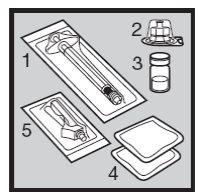
- Humira is a liquid that should appear clear and colorless. DO NOTuse it if the liquid is cloudy, whitish, or has lumps or particles in suspension.
- Preparation of the Humira injectable dose
General handling: DO NOTdispose of any used items until the injection is complete.
- Prepare the needle by partially removing the packaging from the end closest to the yellow connector for the syringe. Remove the packaging just enough to expose the yellow connector for the syringe. Place the packaging with the transparent face up.
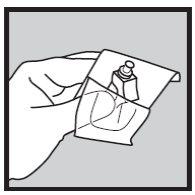
- Remove the white plastic cap from the vial to see the top of the vial stopper.
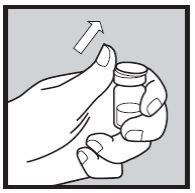
- Use one of the alcohol swabs to clean the vial stopper. DO NOTtouch the vial stopper after cleaning it with the swab.
- Remove the cover from the vial adapter packaging, but do not remove it.
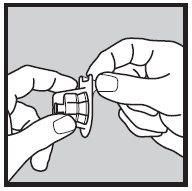
- Hold the vial with the stopper facing up.
- While holding the vial adapter in its transparent packaging, attach it to the vial stopper by pushing until it clicks into place.
- When you are sure the adapter is securely attached to the vial, remove the adapter packaging from the vial.
- Carefully place the vial with the adapter attached on your clean work surface, taking care not to drop it. DO NOTtouch the vial adapter.
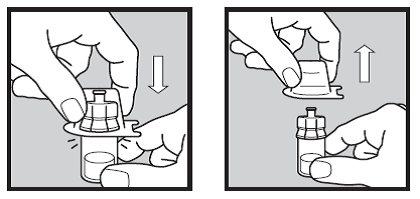
- Prepare the syringe by partially removing the packaging from the end closest to the white plunger.
- Remove the packaging just enough to expose the white plunger, without removing the syringe from its packaging.
- Hold the syringe in its packaging and SLOWLYpull the white plunger until you pass 0.1 ml beyond the prescribed dose (for example, if the prescribed dose is 0.5 ml, pull the white plunger until 0.6 ml). NEVERpull the plunger beyond the 0.9 ml position, regardless of the prescribed dose.
- The volume corresponding to the prescribed dose will be determined later.
- DO NOTpull the white plunger all the way out of the syringe.
NOTE:
If the white plunger is pulled completely out of the syringe, discard the syringe and contact your Humira supplier to have it replaced. DO NOTattempt to reinsert the white plunger.
| Dose + 0.1 ml |
- DO NOTuse the white plunger to remove the syringe from its packaging. Hold the syringe by the graduated area and pull it out of its packaging. DO NOTturn the syringe at any time.
- While holding the vial adapter firmly, insert the tip of the syringe into the vial adapter and screw it in by turning it clockwise until it is secure. DO NOTovertighten.
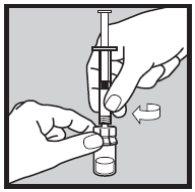
- While holding the vial, push the white plunger down until the end. This step is important to achieve the correct dose. Hold the white plunger and turn the vial and syringe upside down.
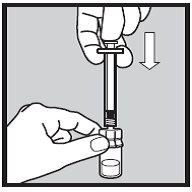
- Pull the white plunger SLOWLYuntil you pass 0.1 ml beyond the prescribed dose. This is very important to achieve the correct dose. The prescribed dose will be introduced in step 4, Preparation of the dose. If the prescribed dose is 0.5 ml, pull the white plunger until the 0.6 ml mark. You will see the medication passing from the vial to the syringe.
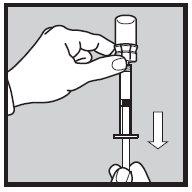
- Push the white plunger down until the end to push the medication back into the vial. Push the white plunger SLOWLYagain until you pass 0.1 ml beyond the prescribed dose, which is important to achieve the correct dose and to prevent air bubbles or air spaces in the medication. The prescribed dose will be introduced in step 4, Preparation of the dose.
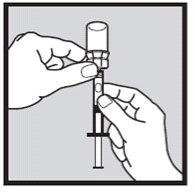
- This process can be repeated up to 3 times if you continue to see air bubbles or air spaces in the syringe medication. DO NOTshake the syringe.
NOTE:
If the white plunger is pulled completely out of the syringe, discard the syringe and contact your Humira supplier to have it replaced. DO NOTattempt to reinsert the white plunger.
- While holding the syringe by the graduated area, remove the vial adapter with the vial by unscrewing the vial adapter. Make sure to remove the vial adapter with the vial from the syringe. DO NOTtouch the tip of the syringe.
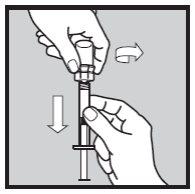
- If you can see a large air bubble or air space near the tip of the syringe, push the white plunger SLOWLYuntil the liquid starts to enter the tip of the syringe. DO NOTpush the white plunger beyond the dose position.
- For example, if the prescribed dose is 0.5 ml, DO NOTpush the white plunger beyond the 0.5 ml position.
- Check that the liquid remaining in the syringe is at least the volume of the prescribed dose. If the volume is less than the prescribed dose, DO NOTuse the syringe and contact your doctor.
- With your free hand, take the needle packaging with the yellow connector for the syringe upside down.
- While holding the syringe upright, insert the tip of the syringe into the yellow connector and turn the syringe as indicated by the arrow in the drawing until it is secure. The needle is now attached to the syringe.
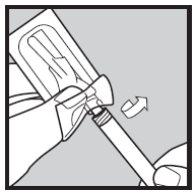
- Remove the needle packaging, but DO NOTremove the clear needle cover.
- Place the syringe on your clean work surface. Continue with the preparation of the injection site and dose immediately.
- Selection and preparation of the injection site.
- Choose an area on your thigh or abdomen. DO NOTuse the same area you used for the last injection.
- The new injection site must be at least 3 cm away from the site of the last injection.
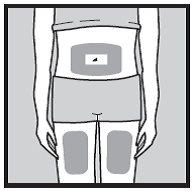
- DO NOTinject into an area where the skin is red, bruised, or hardened. This could mean there is an infection, and you should contact your doctor.
- To reduce the risk of infection, clean the injection site with the other alcohol swab. DO NOTtouch this area again before the injection.
- Preparation of the dose
- Hold the syringe with the needle pointing up.
- Use your other hand to pull the pink needle cover down toward the syringe.
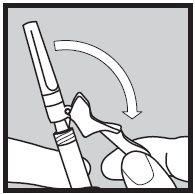
- With your other hand, remove the clear needle cover by pulling it upward.
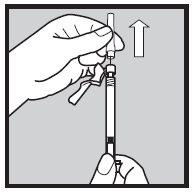
- The needle is clean.
- DO NOTtouch the needle.
- NEVERplace the syringe upside down after removing the clear needle cover.
- NEVERattempt to put the clear needle cover back on.
- Hold the syringe at eye level with the needle pointing up to see the liquid clearly. Be careful not to let the liquid drip into your eyes.
- Verify the prescribed medication dose again.
- Push the white plunger carefully in the syringe until it contains the prescribed amount of medication. Excess liquid may come out of the needle while pushing the plunger. DO NOTclean the needle or syringe.
- Injection of Humira
- With your free hand, gently pinch the clean skin area and hold it firmly.
- With your other hand, hold the syringe at a 45-degree angle to the skin.
- With a short and quick motion, insert the entire needle into the skin.
- Release the skin area you were holding with your hand.
- Push the plunger to inject the medication until the syringe is empty.
- When the syringe is empty, remove the needle from the skin, taking care to pull it out at the same angle it was inserted.
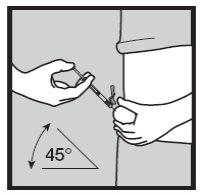
- Push the pink needle cover carefully up over the needle, and click it into place. Place the syringe with the needle on your work surface. DO NOTput the clear needle cover back on.
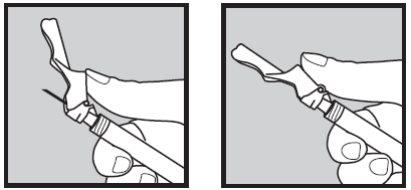
- Using a little cotton, press on the injection site for 10 seconds. It may bleed a little. DO NOTrub the injection site. You can use a band-aid if you want.
- Disposal of materials
- You will need a special container for waste, such as a sharps container, as explained by your nurse, doctor, or pharmacist.
- Place the syringe with the needle, the vial, and the vial adapter in a special container for sharps, DO NOTput these items in your household trash.
- The syringe, needle, vial, and adapter must not be reused.
- Keep this special container out of sight and reach of children at all times.
- Throw away the rest of the items in your household trash.
If you use more Humira than you should
If you accidentally use more Humira than you should, contact your doctor or pharmacist immediately.
4. Possible side effects
Like all medicines, this medicine can cause side effects, although not everybody gets them. Most side effects are mild to moderate. However, some can be serious and require treatment. Side effects may appear at least up to 4 months after the last injection of Humira.
Contact your doctor immediately if you notice any of the following effects
- severe rash, hives, or other signs of allergic reaction;
- swelling of the face, hands, feet;
- difficulty breathing, swallowing;
- shortness of breath when exercising or when lying down, swelling of feet.
Contact your doctor as soon as possible if you notice any of the following effects
- signs of infection such as fever, nausea, wounds, dental problems; burning sensation when urinating;
- feeling of weakness or fatigue;
- cough;
- tingling;
- numbness;
- double vision;
- weakness in arms or legs;
- a lump or an open wound that does not heal;
- signs and symptoms of blood disorders such as persistent fever, bruising, bleeding, and paleness.
The symptoms described above may be signs of the following side effects, which have been observed with Humira.
Very common (may affect more than 1 in 10 people)
- reactions at the injection site (including pain, swelling, redness, or itching);
- lower respiratory tract infections (including colds, runny nose, sinusitis, pneumonia);
- headache;
- abdominal pain;
- nausea and vomiting;
- rash;
- muscle pain.
Common (may affect up to 1 in 10 people)
- severe infections (including sepsis and flu);
- intestinal infections (including gastroenteritis);
- skin infections (including cellulitis and herpes);
- ear infection;
- oral infections (including dental infection and cold sore);
- infections of the reproductive system;
- urinary tract infection;
- fungal infections;
- joint infections;
- benign tumors;
- skin cancer;
- allergic reactions (including seasonal allergy);
- dehydration;
- mood changes (including depression);
- anxiety;
- difficulty sleeping;
- sensory disturbances such as tingling, prickling, or numbness;
- migraine;
- nerve root compression (including lower back pain and leg pain);
- visual disturbances;
- eye inflammation;
- eyelid inflammation and eye swelling;
- vertigo;
- feeling of rapid heartbeat;
- high blood pressure;
- flushing;
- bruising;
- cough;
- asthma;
- difficulty breathing;
- gastrointestinal bleeding;
- indigestion (indigestion, bloating, and heartburn);
- acid reflux;
- dry eye syndrome (including dryness in eyes and mouth);
- itching;
- itchy rash;
- bruising;
- skin inflammation (such as eczema);
- breaking of fingernails and toenails;
- increased sweating;
- hair loss;
- new or worsening psoriasis;
- muscle spasms;
- blood in urine;
- kidney problems;
- chest pain;
- edema;
- fever;
- low platelet count in blood, which increases the risk of bleeding or bruising;
- wound healing problems.
Uncommon (may affect up to 1 in 100 people)
- opportunistic infections (including tuberculosis and other infections that occur when disease resistance decreases);
- neurological infections (including viral meningitis);
- eye infections;
- bacterial infections;
- diverticulitis (inflammation and infection of the large intestine);
- cancer;
- cancer affecting the lymphatic system;
- melanoma;
- immune system disorders that can affect the lungs, skin, and lymph nodes (the most common presentation is sarcoidosis);
- vasculitis (inflammation of blood vessels);
- tremor;
- stroke;
- neuropathy;
- hearing loss, tinnitus;
- feeling of irregular heartbeat like skips;
- heart problems that can cause difficulty breathing or swelling of ankles;
- heart attack;
- aneurysm of a major artery, inflammation, and clotting in a vein, blockage of a blood vessel;
- lung diseases that can cause difficulty breathing (including inflammation);
- pulmonary embolism (blockage of a pulmonary artery);
- pleural effusion (abnormal fluid accumulation in the pleural space);
- pancreatitis that causes severe abdominal and back pain;
- difficulty swallowing;
- facial edema;
- gallbladder inflammation; gallstones;
- fatty liver;
- night sweats;
- scarring;
- abnormal muscle crisis;
- systemic lupus erythematosus (including skin inflammation, heart, lungs, joints, and other organs);
- sleep disturbances;
- impotence;
- inflammations.
Rare (may affect up to 1 in 1000 people)
- leukemia (cancer that affects the blood and bone marrow);
- severe allergic reaction with shock;
- multiple sclerosis;
- nerve disorders (such as optic neuritis and Guillain-Barré syndrome that can cause muscle weakness, abnormal sensations, tingling in the arms and upper body);
- cardiac arrest;
- pulmonary fibrosis (scarring in the lung);
- intestinal perforation;
- hepatitis;
- reactivation of hepatitis B virus;
- autoimmune hepatitis (inflammation of the liver caused by the body's own immune system);
- cutaneous vasculitis (inflammation of blood vessels in the skin);
- Stevens-Johnson syndrome (early symptoms include discomfort, fever, headache, and rash);
- facial edema associated with allergic reactions;
- erythema multiforme (inflammatory rash on the skin);
- lupus-like syndrome;
- angioedema (localized skin inflammation);
- lichenoid reaction on the skin (purple-red rash with itching)
Frequency not known (cannot be estimated from the available data)
- hepatosplenic T-cell lymphoma (a rare and often fatal blood cancer);
- Merkel cell carcinoma (a type of skin cancer);
- Kaposi's sarcoma, a rare cancer related to human herpesvirus 8 infection. Kaposi's sarcoma usually occurs more frequently as purple skin lesions;
- liver failure;
- worsening of a disease called dermatomyositis (seen as a skin rash accompanied by muscle weakness);
- weight gain (for most patients, weight gain was reduced).
Some side effects observed in clinical trials do not have symptoms and can only be identified by a blood test. These include:
Very common (may affect more than 1 in 10 people)
- low white blood cell count;
- low red blood cell count;
- increased lipids in blood;
- increased liver enzymes.
Common (may affect up to 1 in 10 people)
- high white blood cell count;
- low platelet count;
- increased uric acid in blood;
- abnormal sodium levels in blood;
- low calcium level in blood;
- low phosphate level in blood;
- high blood sugar;
- high lactate dehydrogenase levels in blood;
- presence of autoantibodies in blood;
- low potassium level in blood.
Uncommon (may affect up to 1 in 100 people)
- elevated bilirubin levels (liver function test).
Rare (may affect up to 1 in 1000 people)
- low counts in blood for white blood cells, red blood cells, and platelets.
Reporting of side effects
If your child experiences any side effects, consult with your child's doctor or pharmacist, even if it's a possible side effect that is not listed in this leaflet. You can also report them directly through the national reporting system included in Annex V. By reporting side effects, you can help provide more information on the safety of this medicine.
5. Storage of Humira
Keep this medicine out of sight and reach of children.
Do not use this medicine after the expiry date stated on the carton after “EXP”.
Store in a refrigerator (between 2°C and 8°C). Do not freeze.
Keep the vial in the outer packaging to protect it from light.
Medicines should not be disposed of via wastewater or household waste. Ask your doctor or pharmacist how to dispose of the packaging and any unused medicine. This will help protect the environment.
6. Package contents and additional information
Composition of Humira
The active substance is adalimumab.
The other ingredients are: mannitol, citric acid monohydrate, sodium citrate, sodium dihydrogen phosphate dihydrate, disodium phosphate dihydrate, sodium chloride, polysorbate 80, sodium hydroxide, and water for injections.
Appearance and package contents of the product
Humira 40 mg solution for injection in vials is supplied as a sterile solution of 40 mg of adalimumab dissolved in 0.8 ml of solution
The Humira vial is a glass vial containing a solution of adalimumab. One pack contains two boxes, each with 1 vial, 1 empty sterile syringe, 1 needle, 1 vial adapter, and two alcohol swabs.
Humira may be available in a vial, pre-filled syringe, and/or pre-filled pen.
Marketing authorisation holder
AbbVie Deutschland GmbH & Co. KG
Knollstrasse
67061 Ludwigshafen
Germany
Manufacturer
AbbVie Biotechnology GmbH
Knollstrasse
67061 Ludwigshafen
Germany
You can request more information about this medicine by contacting the local representative of the marketing authorisation holder.
Belgium AbbVie SA Tel: +32 10 477811 | Lithuania AbbVie UAB Tel: +370 5 205 3023 |
| Luxembourg AbbVie SA Belgium Tel: +32 10 477811 |
Czech Republic AbbVie s.r.o. Tel: +420 233 098 111 | Hungary AbbVie Kft. Tel: +36 1 455 8600 |
Denmark AbbVie A/S Tel: +45 72 30-20-28 | Malta V.J.Salomone Pharma Limited Tel: +356 21220174 |
Germany AbbVie Deutschland GmbH & Co. KG Tel: 00800 222843 33 (toll-free) Tel: +49 (0) 611 / 1720-0 | Netherlands AbbVie B.V. Tel: +31 (0)88 322 2843 |
Estonia AbbVie OÜ Tel: +372 623 1011 | Norway AbbVie AS Tel: +47 67 81 80 00 |
Greece AbbVie ΦΑΡΜΑΚΕΥΤΙΚΗ Α.Ε. Tel: +30 214 4165 555 | Austria AbbVie GmbH Tel: +43 1 20589-0 |
Spain AbbVie Spain, S.L.U. Tel: +34 91 384 09 10 | Poland AbbVie Polska Sp. z o.o. Tel: +48 22 372 78 00 |
France AbbVie Tel: +33 (0) 1 45 60 13 00 | Portugal AbbVie, Lda. Tel: +351 (0)21 1908400 |
Croatia AbbVie d.o.o. Tel: +385 (0)1 5625 501 | Romania AbbVie S.R.L. Tel: +40 21 529 30 35 |
Ireland AbbVie Limited Tel: +353 (0)1 4287900 | Slovenia AbbVie Biofarmacevtska družba d.o.o. Tel: +386 (1)32 08 060 |
Iceland Vistor hf. Tel: +354 535 7000 | Slovakia AbbVie s.r.o. Tel: +421 2 5050 0777 |
Italy AbbVie S.r.l. Tel: +39 06 928921 | Finland AbbVie Oy Tel: +358 (0) 10 2411 200 |
Cyprus Lifepharma (Z.A.M.) Ltd Tel: +357 22 34 74 40 | Sweden AbbVie AB Tel: +46 (0)8 684 44 600 |
Latvia AbbVie SIA Tel: +371 67605000 |
Date of last revision of this leaflet
Detailed information on this medicine is available on the European Medicines Agency website: http://www.ema.europa.eu.
To request a copy of this leaflet inbraille, large print, or audio, contact the local representative of the marketing authorisation holder.
- Country of registration
- Active substance
- Prescription requiredYes
- Manufacturer
- This information is for reference only and does not constitute medical advice. Always consult a licensed doctor before taking any medication. Oladoctor is not responsible for medical decisions based on this content.
- Alternatives to HUMIRA 40 mg/0.8 ml INJECTABLE SOLUTION FOR PAEDIATRIC USEDosage form: INJECTABLE, 20 mgActive substance: adalimumabManufacturer: Amgen Europe B.V.Prescription requiredDosage form: INJECTABLE, 20 mgActive substance: adalimumabManufacturer: Amgen Europe B.V.Prescription requiredDosage form: INJECTABLE, 40 mgActive substance: adalimumabManufacturer: Amgen Europe B.V.Prescription required
Alternatives to HUMIRA 40 mg/0.8 ml INJECTABLE SOLUTION FOR PAEDIATRIC USE in other countries
The best alternatives with the same active ingredient and therapeutic effect.
Alternative to HUMIRA 40 mg/0.8 ml INJECTABLE SOLUTION FOR PAEDIATRIC USE in Ucrania
Online doctors for HUMIRA 40 mg/0.8 ml INJECTABLE SOLUTION FOR PAEDIATRIC USE
Discuss dosage, side effects, interactions, contraindications, and prescription renewal for HUMIRA 40 mg/0.8 ml INJECTABLE SOLUTION FOR PAEDIATRIC USE – subject to medical assessment and local rules.



